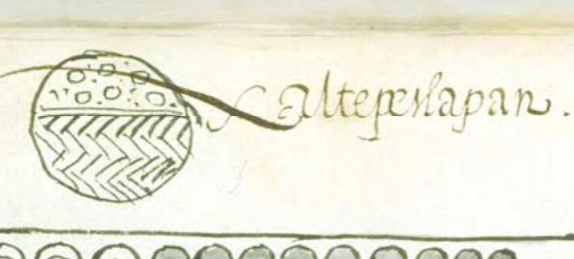Xaltepetlapan (Chav9)
This black-line drawing of the compound glyph for the place name Xaltepetlapan (perhaps "On the Sandy Mountains") is a bird's eye view of a circle with two halves. The top half contains sand (xalli), which appears to be mixed with stone (tetl), another part of the place name. Xaltetl is pumice, and so the sand and stone could provide phonetic indicators for this term. Or this could just be a visual for sand. The bottom half contains a woven mat (petlatl). This seems to be a phonetic indicator for tepetla (mountains or mountainous region). The locative suffix (-pan, on) is not shown visually. But the church next to the place glyph (or part of it) provides a semantic locative.
Stephanie Wood
It is worthy of note that sand and small stones are often contained within a circle or another shape in glyphs across multiple manuscripts. In this collection, when we publish elements of compound that involve sand, the elements do not always have their containing borders anymore.
Stephanie Wood
xaltepetlapan
Xaltepetlapan
Stephanie Wood
1578
Stephanie Wood
sand, arenas, stones, piedras, mats, petates, pómez, nombres de lugares

xal(li), sand, https://nahuatl.wired-humanities.org/content/xalli
tepetla, a mountainous region, https://nahuatl.wired-humanities.org/content/tepetla
te(tl), rocks, stones, https://nahuatl.wired-humanities.org/content/tetl-0
xalte(tl), pumice, https://nahuatl.wired-humanities.org/content/xaltetl
petla(tl), woven mat, https://nahuatl.wired-humanities.org/content/petlatl
-pan (locative suffix), on, https://nahuatl.wired-humanities.org/content/pan
En las Montañas Arenosas
Stephanie Wood
The Codex Chavero of Huexotzinco (or Códice Chavero de Huexotzinco), https://www.loc.gov/resource/gdcwdl.wdl_03246_001/?sp=9
The Codex Chavero of Huexotzinco (or Códice Chavero de Huexotzinco) is held by the Instituto Nacional de Antropología e Historia, México. It is published online by the World Digital Library and the Library of Congress, which is “unaware of any copyright or other restrictions in the World Digital Library Collection.”









